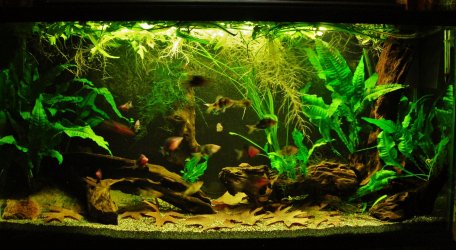pdlawson
New Member
- Joined
- Mar 1, 2017
- Messages
- 7
- Reaction score
- 0
Hope someone can help.
I had a well established tank with some cichlids in for a number of years. Through time and natural wastage the number of fish dwindled to just a jewel and a rainbow cichlid. Wanting to restock the tank I took the step of rehoming the remaining two fish and changing tack with what I had in the tank.
So I have moved away from cichlids and put Tiger Barbs in the tank (thought it might make a nice change) ... They are the only fish in the tank now.
The Barbs are young fish at the moment (about 1/2" long) and I have a shoal of 20 (a half and half split with green Tiger Barbs and normal orange Tiger Barbs)
When I first put them in the tank after a period of acclimatisation they swam around the tank in a large group and looked very happy. However, a day later it is as if the tank is completely empty. They have all taken to hiding under the plants at the back of the tank.
The tank has remained the same (well planted, well filtered, regular water changes, virtually no algae, good water quality with PH levels and ammonia levels) It has twin T5 daylight lighting strips, which are on a timer which puts the lighting on and off throughout the day (the longest "on" period is in the evening when we're home)
I am assuming the fish are just "getting used to" their new home (???) Is that correct? Does anyone have a similar experience?
Any pointers would be appreciated ...
I had a well established tank with some cichlids in for a number of years. Through time and natural wastage the number of fish dwindled to just a jewel and a rainbow cichlid. Wanting to restock the tank I took the step of rehoming the remaining two fish and changing tack with what I had in the tank.
So I have moved away from cichlids and put Tiger Barbs in the tank (thought it might make a nice change) ... They are the only fish in the tank now.
The Barbs are young fish at the moment (about 1/2" long) and I have a shoal of 20 (a half and half split with green Tiger Barbs and normal orange Tiger Barbs)
When I first put them in the tank after a period of acclimatisation they swam around the tank in a large group and looked very happy. However, a day later it is as if the tank is completely empty. They have all taken to hiding under the plants at the back of the tank.
The tank has remained the same (well planted, well filtered, regular water changes, virtually no algae, good water quality with PH levels and ammonia levels) It has twin T5 daylight lighting strips, which are on a timer which puts the lighting on and off throughout the day (the longest "on" period is in the evening when we're home)
I am assuming the fish are just "getting used to" their new home (???) Is that correct? Does anyone have a similar experience?
Any pointers would be appreciated ...



